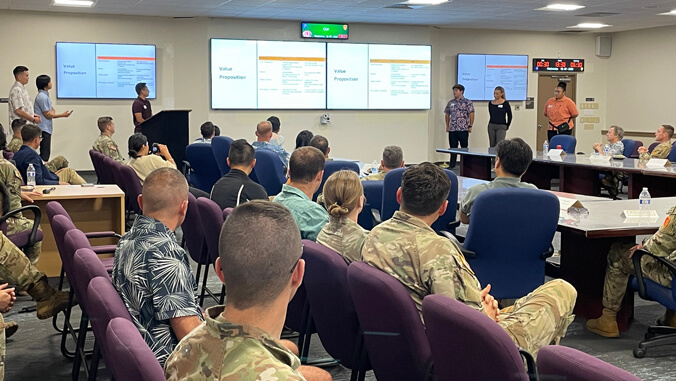
University of Hawaiʻi students have developed innovative and viable solutions to address critical problems facing the Department of Defense (DoD), ranging from decreasing injury and death during rescue missions to improving aircraft and personnel operations. They delivered presentations on campus and at Schofield Barracks on December 7.
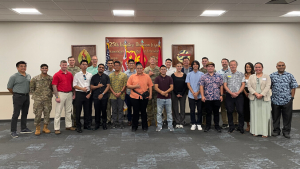
The projects were created through semester-long UH Mānoa courses developed as part of the fall 2022 DoD’s National Security Innovation Network’s (NSIN) Hacking for Defense® (H4D™) and Capstone program. Multidisciplinary student teams from UH Mānoa’s College of Engineering, College of Natural Sciences and Shidler College of Business learned and applied entrepreneurial skills while working with the DoD to identify and develop viable products and early-stage prototypes.
Since launching the H4D™ program at UH in spring 2021, 47 students have participated in H4D™, and six have obtained internships with NSIN, Booz Allen Hamilton and other companies. Fifty students have participated in Capstone since the fall 2020 semester, and five have attributed securing internships or jobs as a result.
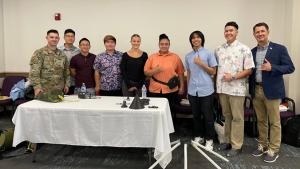
“Our partnership with NSIN helps to strengthen the university’s relationship with the DoD and increases the number of opportunities to collaborate with them,” said Vassilis L. Syrmos, UH vice president for research and innovation. “NSIN’s programs provide invaluable expertise and experiences for our students and faculty to gain real-world innovation and entrepreneurship training, while also providing career and business opportunities to the teams.”
Throughout NSIN’s H4D™ and Capstone courses, participants learn and apply the Lean Startup methodology to develop business and mission model canvases; discover and validate customer needs; and apply agile engineering in building and testing iterative prototypes.
“The challenge of having to work in multidisciplinary teams while navigating the DoD’s complex process requires discipline, and it also provides incredible workforce development and training opportunities not just for our UH students and faculty, but the soldiers working on the projects as well,” said Gloria Choo, UH NSIN regional engagement principal. “Participants have mentioned that the program has really helped with their communications and presentation skills as well as how they approach problem solving.”
Fall 2022 H4D™ projects:
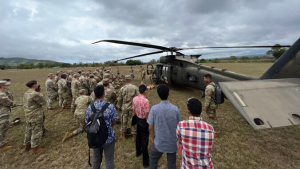
- Team Icarus presented solutions ranging from LED-light pathways to incorporating drone speakers to avert spectators from coming near helicopter rotor blades when having to land in urban environments without non-designated landing zones (i.e., helipads), in order to prevent accidental injury or death.
- Team Stability on the Rise developed and presented their Downwash Shield, an advanced technology to decrease patient stretcher spinout while on a helicopter Sked® Basic Rescue System to improve patient transportation safety.
- Team Tracking Sidewinders presented a prototype of a web application that consolidates and tracks personnel training and certification data to ensure soldiers are consistently certified for deployment and career advancement, and the Army and Air Force are prepared for any potential mass medical casualty response needs.
Information and computer sciences capstone projects:
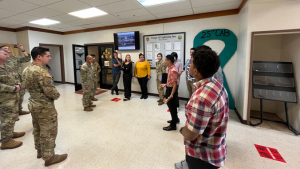
- Augmented Intelligence Natural Language Processing team further developed a prototype app to support aircraft maintenance by investigating how natural language processing can be used to improve data accuracy of squadron maintenance records, and enhance the user experience.
- Phase Maintenance Inspection Software team presented a proof-of-concept software that can better forecast, manage and assess mission-critical phase maintenance inspections of its fleet of rotary wing aircrafts by leveraging and synchronizing automation and data analytics. This will improve aviation sustainment capabilities, maintenance quality and predictability for soldiers and their families to prepare for training.
- Digital Wargame Development team continued to develop and enhance an app that supports deployment logistics and planning, including the delivery and sustainment of supplies, munitions, etc.
Mechanical engineering capstone projects:
- Airfield Debris from Launching Aircraft team developed a blueprint for a humvee trailer attachment and protective casing for a remote-controlled industrial debris blower to provide a safer and more efficient means of clearing potentially explosive munitions from airfields when flying in and out of enemy territory.
- Fuel Sampling in Aircraft team is developing a prototype for a hand pump that is directly connected to a UH-60 (Black Hawk helicopter) that is more efficient and safer for crew members to sample fuel, preventing potential fuel contamination and exposure to toxic, corrosive fuel and reducing fuel preparation time.
- Patient Warmer for Marines team developed technology to prevent morbidity and mortality rates of treating trauma patients with hypothermia, and overcome logistical challenges of requiring electricity for other treatment options.
NSIN programs are housed in the UH Office of Innovation and Commercialization and are among several programs designed to elevate the research, innovation and entrepreneurship created throughout the 10-campus UH System. For more information about NSIN programs, visit nsin.mil.

